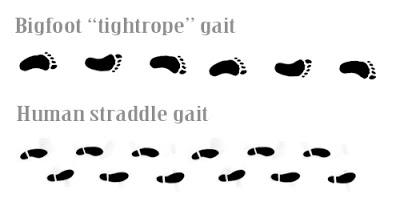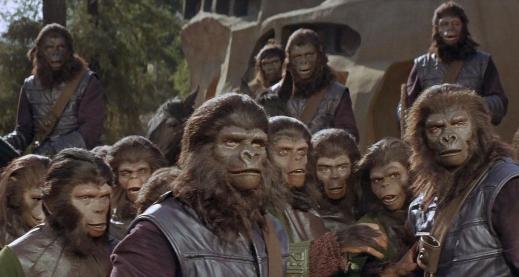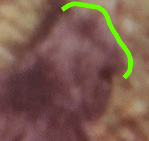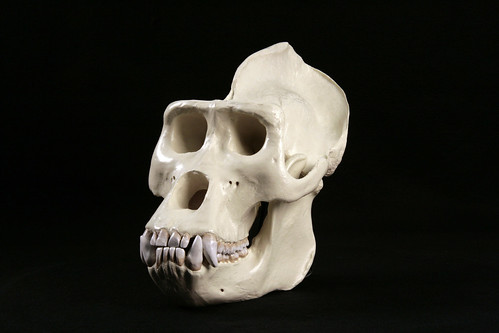"Once you eliminate the impossible, whatever remains, no matter how improbable, must be the truth"- Arthur Conan Doyle
THE MOST ANALYZED FILM FOOTAGE EVER, NEXT TO THE 1963 KENNEDY ASSASSINATION FILM! The greatest proof of the existence of Bigfoot; The Patterson/Gimlin Film. Since it's filming by Roger Patterson and Bob Gimlin in Northern California in October of 1967, it has remained a complete mystery, far beyond any rational explanation. Even with today's modern computer technology, the 953 frames of 16mm footage still manages to evade any evidence that the film was a perpetrated hoax made by two cowboys seeking fame. Watching the Patterson/Gimlin film in an attempt to find a rational explanation is like 'falling down the rabbit hole', it only becomes more and more mysterious, a journey into the unknown. When anthropologists and professional Hollywood costume designers study the footage for years and conclude that the figure is a non-human primate living in North America and not 'some guy in a gorilla suit', then we should all keep an open mind and accept the possibility that Sasquatch are real. Any attempt to prove that it's fake so far always leads to a dead end. In fact there is always something new to find out about the film and therefore it never gets old. So here on this webpage I will attempt to explain the four main non-human characteristics of the Patterson/Gimlin Bigfoot that suggest it is a real primate; walking pattern, height and weight, body hair ( or 'costume' ) and body ratios.

THE ORIGINAL PATTERSON BIGFOOT FILM IN ITS ENTIRETY.....
Here is a clip about the Patterson/Gimlin Film from 'In Search of Bigfoot' from 1976, hosted by Leonard Nimoy...
This video is an excellent introduction to the 1967 Patterson/Gimlin film, including an interview with Bob Gimlin from 2004...
Brand new 4K digitally remastered ( stabilized and motion smoothing from 24 FPS to 60 FPS ) version of the 1967 Patterson/Gimlin Bigfoot film....all the major muscle groups such as the deltoids, biceps, triceps and femurs ( leg muscles ) are clearly visible now.
The walking pattern, also know as 'gait', of the Patterson Bigfoot is extremely unusual and clearly non-human. Nevertheless the steps are executed perfectly smoothly with no signs of awkwardness or struggle, all while the creature is not looking at the ground nor looking in the direction of travel ( as we see when the Bigfoot turns its head in the famous 352 frame ). An examination of the footprints revealed that the Bigfoot was walking a minimal gait, as if it were walking a tightrope. Humans on the other hand walk with a much wider gait, with the left and right steps being much wider ( see illustration below ).
Another notable characteristic of the Patterson Bigfoot's walk is the degree to which the back leg rises, almost parallel to the ground! Here is a video by ThinkerThunker comparing the Patterson Bigfoot's walk to a human walk...
Below left, a photo of a footprint made by the Patterson Bigfoot ( 14.5 inches in length, 6 inches wide ). It clearly shows a midtarsal break, which indicates that the foot flexes in the middle. The purpose of the midtarsal break is to allow for easier and more efficient walking over uneven terrain. Unlike humans, where the foot does not flex in the middle but instead at the front of the foot ( right ).
Bob Gimlin discusses the giant steps taken by the Patterson Bigfoot in this video.....they were measured between 42" and 48" from toe to heel!!
In this video an athlete in an controlled environment attempts to simulate the unconventional walk of the Patterson Bigfoot, and couldn't do it!
Odds of successfully walking the Patterson Bigfoot walk:
Due to the extreme difficulty that the Patterson Bigfoot executes flawlessly in each step with its known characteristics ( 'tightrope walking' gait, raised back foot, bent forward knee, all while moving over uneven terrain and wearing a bulky costume that would be difficult to see and breathe in ), the odds of each step being successfully taken by a 'man in a suit' are about one in two, and that's being generous. It's the same odds of tossing a coin and landing on heads. So what would be the odds of taking 200 successful steps in a row ( approximate number of steps taken in the Patterson film )? The same as tossing a coin 200 times and each time landing on heads. The odds are preposterously low! The odds diminish exponentially with each step, one step 1 in 2, two steps 1 in 4, three steps 1 in 8 and so on. When we get to higher numbers the odds become very remote for a successful walk; 10 steps 1 in 1024, 15 steps one in 32,768, 20 steps 1 in 1,048,576, and 30 steps 1 in 2,147,483,648! 200 steps becomes impossibly remote. Just how many takes would they have to do in order to get it right? So clearly the odds of Sasquatch existing in North America and successfully avoiding human contact for hundreds of years are far far better than an 'man in a suit' walking the walk we see in the Patterson film.

It is difficult to determine exactly how tall the Patterson Bigfoot is, since there are no objects of standard size within the film. However, using known reference points such at the length of the foot ( 14.5 inches ), the average width of Aspen trees ( which the Bigfoot is seen walking beside ), the height of Roger Patterson and his approximate distance from the creature, several calculations have been taken to estimate its exact height, ranging from 7 feet tall to to 7 foot 8 inches tall. Every calculation seems to show that the Bigfoot is far outside the dimensions of a human. The chest circumference and the width of the shoulders are far beyond the human range. And only one in one hundred million people reach the height of 7 foot 8 inches. If you are in a room with an average ceiling height of 8 feet, then measure four inches down from the ceiling. That's how tall the Patterson Bigfoot was if it were standing straight up!It would not be possible to know the exact weight of the Patterson Bigfoot. Only estimates can be taken based on its approximate dimensions. Several appraisals of its weight have been taken over the years, ranging from 280 lbs to 1,957 lbs. In the video below ThinkerThunker estimates the Bigfoot's weight to be about 720 lbs.
ThinkerThunker estimates the Patterson Bigfoot to be AT LEAST 7 feet tall by using the estimated width of Aspen trees as a measuring tool in this video...
WHY USE A 7' 8" ACTOR?? MAKES NO SENSE...
If it were a 'man in a suit' then why would Roger Patterson need a 7 foot 8 inch actor to play the role of Bigfoot? He could have easily used a 6 foot or even a 5 foot actor and the film would have looked exactly the same. All he would have to do is adjust his distance from the Bigfoot and height of the camera from the ground accordingly. Finding anyone that is 7 foot 8 inches tall would have been extremely difficult ( only one in one hundred million people grow to that height, and the population in California in 1967 was about 19 million, so the chances of finding someone 7 foot 8 inches tall would be very slim indeed ). It all has to do with its size relative to other objects within the film. When viewing to film the trees and bushes have no standard size; they could be very big or very small, depending on our subjective point of view. If the Bigfoot were to walk past an object in which we are familiar with its size ( such as a stop sign, a car or a telephone booth ), then we would be able to see the Bigfoot as it is; a very large creature compared with the dimension of a human. It is only by taking the time to investigate the Patterson film using known variables such as the size of the footprints, the distance from the camera and the Bigfoot ( according to Bob Gimlin ), the distance of the trees relative from each other ( as measured by Rene Dahinden at the actual Bluff Creek location in 1971 ), the size of the lenses on the camera used by Roger Patterson ( a Kodak K-100 16mm camera ) and the average size of Aspen trees ( see Thinkerthunker's video above ).
SO WHO WAS THE UNKNOWN 'MAN IN THE SUIT' ANYWAYS?
The Patterson Bigfoot has been estimated to be 7 foot 6 inches to 7 feet 8 inches tall standing straight up ( 7 foot 3 inches tall in the film with its back hunched over and knees bent ). People that tall end up on the 'World's Tallest People' lists, whether they choose to or not. There were only four people in the U.S. alive in 1967 that were 7 foot 6 inches or taller that would qualify to be the 'man in the suit': 1) Cecil Boling (1920-2000) 7'8". Had his lower legs amputated in 1958 so that rules him out. 2) Conrad Furrows (1922-1967)7'6". He had already died in June 1967 so cross him off the list. 3) Henry Hite (1915-1978) 8'2". Was 8 foot 2 inches tall, at least 8 inches too tall to be the Patterson film. So that just leaves one person who could have been the Patterson Bigfoot, 4) Max Palmer (1927-1984)7'8". He was an actor but only from 1952-1954. Became a preacher in Salt Lake City after ending his acting career until his death in 1984. I cannot find any evidence whatsoever that Max Palmer knew Roger Patterson, did any acting during his preaching career or was involved any way with the Patterson/Gimlin film. So that pretty much rules out everyone on the list. So then who was the mystery 'man in the suit' in the Patterson Bigfoot film if it were faked? Unfortunately people that are extremely tall, such as the heights mentioned above, often suffer from various health problems. They may need to walk with a cane, have a curved spine from bending down too frequently, as well as heart problems. And when they do walk, it is often very cautiously, unlike the ultra-super athleticism that we witness by the Bigfoot in the Patterson Gimlin film. ( for further info on the life of extremely tall humans, check out a video on Youtube called 'DOCS: Superhuman - Giants' )

Those who watch the Patterson/Gimlin film for the first time may quickly conclude that the figure in the film is just a 'man in a costume'. Bill Munns, a professional Hollywood costume designer and make-up artist for the past 50 years, has analysed the footage in great detail and concluded that a costume could not have been made to look and function like the creature in the Patterson film, especially in 1967 when computer animation, mechanical prosthetic limbs and stretch fabric materials did not exist ( The length of the Bigfoot arm is estimated to be about 42" long, way beyond the length of a human arm. The hands and wrist are clearly seen moving from frame to frame ). Also, anthropologists are able to identify specific muscle groups such as the trapezius, the deltoids and the triceps, which are clearly seen moving on the Bigfoot as it walks. Muscle movement would not be visible on a costume.
The best known gorilla costumes in the late 1960's were the the uniforms and make-up from the 1968 movie 'Planet of the Apes', which won an Academy Award for outstanding make-up achievement and an Oscar nomination for Best Costume Design. They were very good costumes and the make-up was exceptional, but nothing compared to what is seen in the Patterson Bigfoot film if it were a hoax. So who was the mysterious costume maker? ( Below, a scene from Planet of the Apes, 1968, Twentieth Century Fox, APJAC Productions ).
This is the closest so far that someone has come to recreating the Patterson Bigfoot 'costume'. It's not even close to what we see in the original 1967 film, and this person spends several years working on it ( with more modern materials in a controlled environment ) as seen in this video...
This video compares the Patterson Bigfoot to the ape costumes in the 'Planet of the Apes' movie from 1968. They are very different!
- 7 feet 6 inches to 7 feet 8 inches tall
- must be in excellent physical condition ( no problems with walking or stamina associated with your height )
- remain unknown to the media about your height and to avoid ending up on 'World's Tallest People' lists
- perform an extremely difficult walking pattern for a full minute while walking over uneven terrain (with sticks and rocks on the ground) and not looking at the ground ( the famous head turn ), and do it perfectly flawlessly and smoothly, without any signs of struggle. Also, the strides and arm swinging must be full, even though a heavy and bulky costume would restrict your movements.
- walking while wearing a big bulky costume that would be difficult to see and breathe through, for at least 200 steps
- be able to operate mechanical prosthetic hands ( which didn't exist in the U.S. 1967! ) as the hands are seen flexing in the film
- don't tell anyone about being involved with and being the star of the greatest hoax ever in the history of mankind and leave ABSOLUTE ZERO evidence behind linking you to the film and Roger Patterson ( 53 years of silence so far )
- do all this deep in the middle of a forest, miles from the nearest town
What would qualify someone to be the 'man in the gorilla suit'?
The theory of a 'man in a suit' defies logic on so many different levels. Why has the 'gorilla suit' from the Patterson film has never been found after all these years? ThinkerThunker explains in this video...
Below left; the Patterson Bigfoot has a sagittal crest ( frame 339 ), a vertical bone on top of the skull where large jaw muscles for chewing are anchored, low at the front and high at the back of the head. Below right; a sagittal crest is clearly visible on the skull of a gorilla. Ape costumes from the 1960's ( or from any time period ) did not have sagittal crests, mainly because the human forehead rises too high at the front. Both the Bigfoot and the gorilla skull have almost no forehead.
Below, the Bigfoot hand clearly changes shape from frames 61 to 307. Since the length of the arm has been estimated to be 42 inches long, it is far outside the dimensions of a human ( the average human adult arm is 30 inches long. Find a measuring tape and pull it out to 42 inches, that's the length of the Patterson Bigfoot arm! ). In order for the hand to flex, a mechanical prosthetic arm extension would be required, which did not exist in the U.S. in 1967. Also, if an arm extension were added, then the elbow would no longer appear to be in the center of the arm, but rather higher up on the arm. Yet the elbows of the Patterson Bigfoot are clearly in the center of the arms.
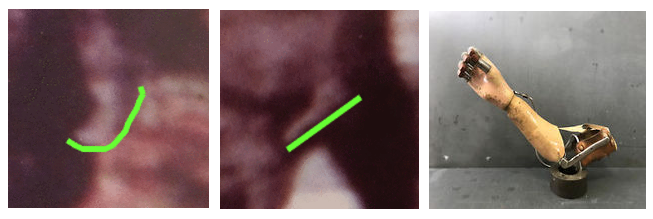

The body ratios of the Patterson Bigfoot, in reference to the length of its arms, legs and torso in relation to each other, do not match the body ratios of a human. Its arms and torso are too long, and the legs are too short. This does not help the 'man in a suit' theory since a person cannot change the location of their elbows, knees, hips and shoulders simply by putting on a costume. The proportions of the Bigfoot we see in the film are closer to that of a Neanderthal than a human. Also, it has almost no neck and its head sits far more forward on its body in relation to its shoulders.
In this video ThinkerThunker compares the body ratios of various sized people compared to other alleged Sasquatch.
Professional Hollywood costume designer Bill Munns uses modern computer technology to compare the body ratios of the Patterson Bigfoot to a human, and suggests that is a real creature. ( @29:55 in the video )
THE PATTERSON BIGFOOT FILMING LOCATION TODAY...
The original Patterson/Gimlin Bigfoot film location at Bluff Creek certainly has changed significantly since the time of its filming in October of 1967. The growth and decay of trees and the erosion of soil have made it almost unrecognizable. Nevertheless, key elements in the film, such as trees, tree stumps and rocks can still be found at the location today. These fundamental points can allow researches to pinpoint the exact location of the Bigfoot's passage, as well as Roger Patterson's filming locations. In this video, Bigfoot researchers examine the exact location of the Patterson/Gilmin film in July of 2020...

After a very comprehensive and detailed analysis of the 1967 Patterson/Gimlin Bigfoot film on its four main characteristics; walking pattern, height and weight, body hair or 'costume' and body ratios, we are left with only two possible outcomes. First, that the Bigfoot in the film is a real hominid and that the species exists today in North America. Second, that the figure in the film is just a man in a gorilla suit that was way beyond the technology of 1967 that is somehow able to break the laws of biomechanics and evade the analytical computer technology of the 21st century. In fact, the more the film is analysed, the more real the Bigfoot appears. Common sense would have it the other way around. It has now been 53 years since the Patterson Bigfoot was filmed, and it has NEVER BEEN REPRODUCED OR PROVEN TO BE FAKE. There are thousands of analytical/discussion videos on Youtube about the Patterson Bigfoot and not a single video of someone perfectly imitating the 1967 Bigfoot film footage, why is that? Why can't critics just recreate the Patterson Bigfoot to prove to us all that it was all a hoax? They have had 53 years to do so. What are they waiting for?
So what is Bigfoot as a species if it were real? It may be a descendant of either Gigantopithicus, Neanderthal, Dryopithecus or Homo Heidelbergensis, and may have crossed over from Asia to North America along with man during the last Ice Age.
Since it has been shown in several analysis videos that the Patterson/Gimlin Bigfoot could not have been hoaxed, we must therefore conclude that what we see in the 1967 film is a real creature. Also, Bigfoot must exist throughout North America since there can't only be one Bigfoot existing ( the Sasquatch we see in the film ). It's entirely possible for the species to exist and evade humans, since there are hundreds of thousands of square miles of sustainable wilderness in North America for it to live in. Maybe now we should take the almost 4,000 reported Bigfoot sightings in the United States and Canada in the past 100 years more seriously, and also take heed of Native American folklore about Sasquatch that has existed for hundreds of years. The mathematical odds of the film being faked, when all the characteristics are taken into consideration, are extremely remote, about one hundred million to one. I believe there is enough evidence in the Patterson/Gimlin film to prove that it is real.


